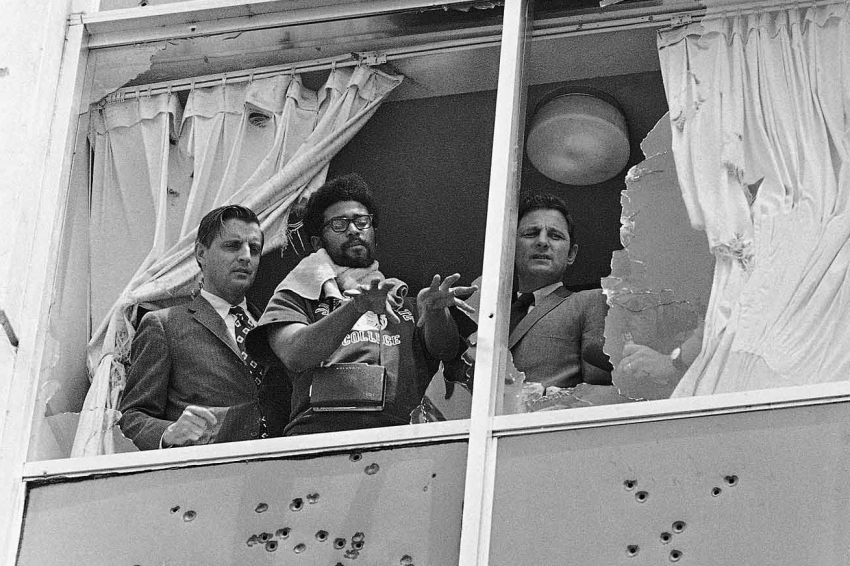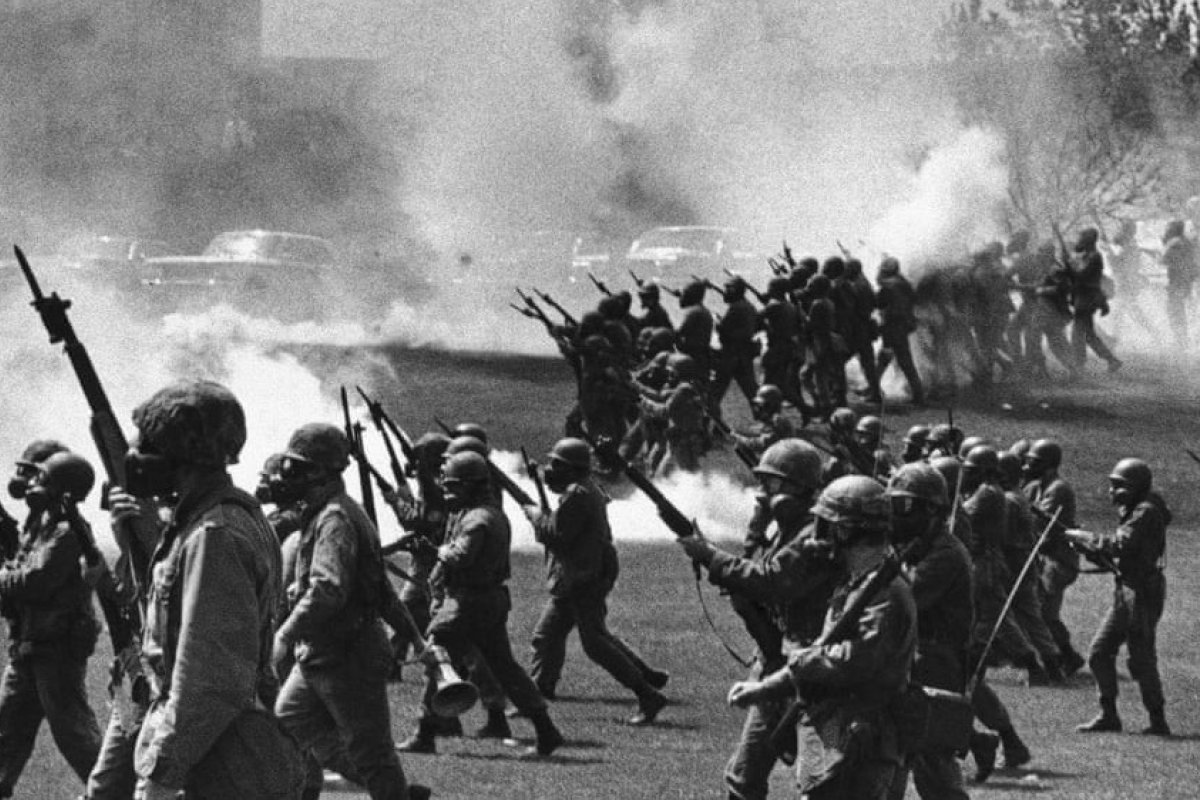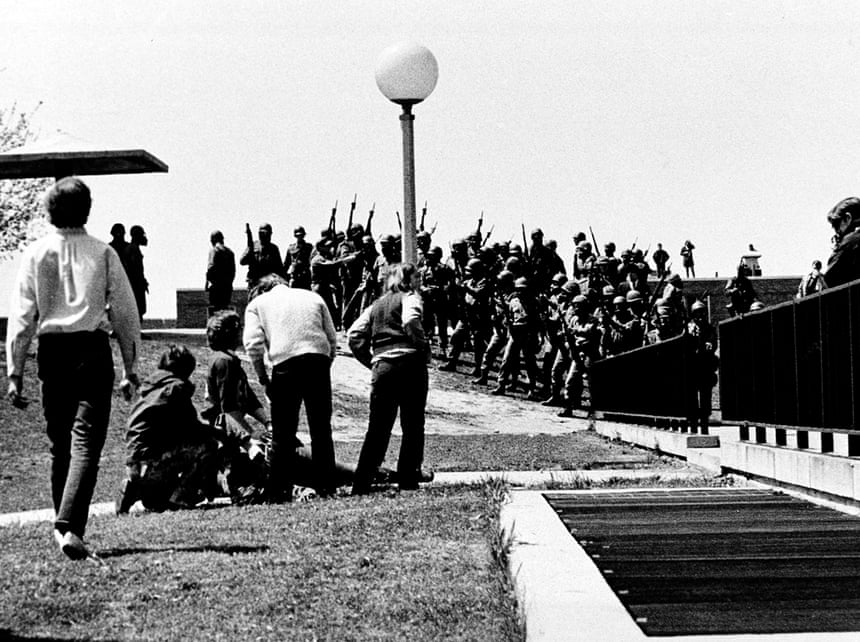|
In the early ensuing years, the University tried to convey that the killings were simply a tragic accident, nothing that the University could have prevented or was responsible for, and nothing anyone should fear happening again. It took a long time to get any physical memorial on the campus. First, on May 4, 1971, the campus B’nai B’rith Hillel dedicated a small memorial stone near where the dead fell; on May 4, 1975, it was rededicated by the faculty. Eventually, the University erected a memorial in the form of several unremarkable slabs of stone. It was not until 2007, after unremitting pressure from a few who would not give up, that the Ohio Historical Society erected a marker near the site.
A proper memorial sculpture does now exist, but it is not at Kent State. The sculptor George Segal, having been commissioned by the University, produced a contemporary representation of Abraham and Isaac. Isaac, the son in cut-off jeans with his wrists bound, is on his knees looking up at his father in supplication. Abraham stands over his son, undeterred, preparing to wield a knife. Kent State officials rejected the sculpture, however, deeming it “too violent.” It is permanently installed at Princeton University, where Segal taught and where the families of Kent’s dead went to make a proper ceremony at its installation.
To its credit, Kent State has carried out a commemoration every year. A candlelight march begins at 11:00 p.m. on May 3. The procession winds its way through campus and ends in the parking lot, where a rabbi says the Kadesh and in recent years a Christian minister has said a prayer as well. Quite coincidentally, three of the four dead were Jewish. Four people stand vigil in half-hour shifts from midnight until noon on May 4 when the commemoration program begins.
In recent years, University presidents have participated in the candlelight procession and sometimes have spoken as well. There is regularly now a breakfast on the morning of May 4 honoring those among the wounded who are still living along with their families. The KSU Bookstore sponsors an annual May 4 morning book-signing for those of us who have published books about Kent.
During the commemoration there is always music. One year, Peter, Paul, and Mary performed. They made their way down to the Commons through the daffodils that had been planted on the hillside where the Guard had marched up. The hill had been planted with over 58,000 daffodils, one for every American killed in Vietnam. At that commemoration, they sang, and all of us with them, “Where Have All the Flowers Gone?” This year we were looking forward to hearing David Crosby perform, of Crosby, Stills, Nash, and Young. We all remember their song, “Four Dead in Ohio.”
Every year there are famous speakers too. Last year Bob Woodward spoke, explicitly about Richard Nixon, though everyone present understood that every word had implicit current application as well. This year, for the fiftieth, the planning committee invited Jane Fonda (to the frustration of some on the right), who of course said she would come.
But after many months of planning and the creation of a rich and varied program, nobody is going back to Kent this May. Some programs will happen virtually. Some will be rescheduled for the fall, or for May 2021.
It would be easy for me to despair about the cancellation of Kent’s 50th anniversary. The truth is I have already done that, but despair is not the end of the story. Some of us were troubled about the commemorations over the years being essentially just memorials—important as those memorials are—with insufficient attention to the context of the killings then and echoes of that context today. Those students were killed and others wounded in the midst of a protest against an unjust war. In the most horrific way the rights of freedom of speech and assembly were abrogated. Even worse, the deadly force of government was unleashed on citizens going about their daily lives, unarmed people who were no threat to the Guardsmen, hundreds of feet away. For years, some people wanted to write off the shootings as acts of individual Guardsmen who panicked in a chaotic situation or who somehow thought they were defending themselves. But it is no longer reasonably questioned that there was an order to fire. The government, not just individuals with loaded weapons, is responsible for the Kent massacre.
I am disappointed that I am not at Kent this year. Still, I rejoice that the program that was to happen included speakers from the Vietnam-era antiwar movement as well as speakers more than ready and able to connect the dots with current events. We can hear David Crosby sing some other time. The now permanently marked-off places in the parking lot where the dead fell will still be there next year to welcome our standing vigil.
The hill above the Commons was replanted in daffodils last fall. The other day a friend sent pictures of that hill now awash again in yellow blooms. I have been assured that a little after noon on May 4, some lone soul will walk down that flowering hill to ring the old victory bell four times very slowly, and then nine more times. In spirit, all of us who have the blood of Kent still running in our souls will be there.
For those of us who survived that day in May of 1970, and for the families and friends of those who did not survive, these annual commemorations offer more than an opportunity to remember what happened at Kent State. They give us the opportunity to acknowledge and tend to moral injuries and spiritual burdens carried now for half a century. Remembrance and soul care are especially important now as our nation has become more, not less, familiar with violence on school and college campuses and elsewhere. And so, for those who cannot go back to Kent State this year, and for others too whose lives have been forever altered by official acts of violence and injustice, I offer this prayer written by Rev. Lyn Cox and adapted by Rev. Steven Protzman, both Unitarian Universalist ministerial colleagues of mine:
Holy One, Spirit that is Love and Life itself,
We bring hearts broken by the violence fifty years ago on the Kent State Campus. Be with us in this time of remembrance. Be with us as we reach out to one another in comfort.
Be with us as we come to terms with our sadness, anger, and despair. Hold us in the embrace of eternal love, even when we forget our connections with each other and with our deepest selves.
Fill our hearts with a thirst for justice, a hunger for righteousness, and help us be those in, with, and through whom our world is transformed. Lead us and bring us together in hope, healing, and action.
May we emerge from this time of lamentation transformed, ready to stand and move and dance together in the service of love and justice.
Hold us in our unity, celebrating life in many voices and singing together as one people ready to create the world we hope and pray and dream for.
All these things we pray for love’s sake.
May it be so and amen.
Remembering the Jackson State Killings
by Rev. Dr. Gordon D. Gibson

Fifty years ago—in May of 1970—fear, anxiety, and uncertainty gripped the nation. The war in Vietnam was raging, with concomitant military draft activity in this country. Many, probably most, campuses across the country experienced student activist resistance to the war, to the draft, and to various other issues that troubled students and other young adults. The dawning of the 1970s came on the heels of a decade that had been marked by assassinations which had traumatized the nation: Medgar Evers (1963), President John F. Kennedy (1963), Malcolm X (1965), the Rev. Dr. Martin Luther King Jr. (1968), and Senator Robert F. Kennedy (1968).
It was in that context that, on May 4, 1970, four students were shot and killed by agents of the state—National Guardsmen in this instance—on the campus of Kent State University in Ohio. The shooting at Kent State garnered national press attention.
Less than two weeks later, just after midnight on May 15, 1970, lethal state violence erupted again on a college campus. This time it was in Jackson, Mississippi, on the campus of Jackson State College (now Jackson State University), a public, historically black college. This time the shooters were officers of the Mississippi Highway Patrol, possibly joined by some Jackson police officers. This time the two unarmed people killed were black. This time the deaths stirred national mention, but they received nowhere near the prolonged attention of the Kent State shooting.
Maybe the disparity in coverage was because violence, including state violence, particularly violence directed against black people, could be thought of as somehow predictable, if not excusable, in Mississippi. After all, it was only eight years prior that Governor Ross Barnett had incited a lethal white riot in an attempt to keep James Meredith out of the University of Mississippi. Maybe the difference was because of the lower body count, combined with the feeling, “Oh, this is almost the same story as ten days ago, a story that’s already been told.” Maybe the difference was that there was vivid photography documenting the daytime killings at Kent State, but the Jackson State killings were at night and unphotographed.
I believe that all six deaths—along with the many persons wounded physically and emotionally in these and other events of the era—need to be remembered and understood in the religious framework Rev. Dr. Martin Luther King Jr. outlined in his 1967 “A Time to Break Silence” address to Clergy and Laity Concerned about Vietnam. In that speech, Dr. King said, “We as a nation must undergo a radical revolution of values. We must rapidly begin the shift from a ‘thing-oriented’ society to a ‘person-oriented’ society. When machines and computers, profit motives and property rights are considered more important than people, the giant triplets of racism, materialism, and militarism are incapable of being conquered.”
Those triplets were certainly at work in 1970. Militarism was running rampant as one administration after another conducted an irrational and unwinnable war in Southeast Asia. This militaristic ethos supplied law enforcement officers and National Guardsmen with substantial firepower on campuses and other locales to exert control here at home. America was far from a “person-oriented” society. Materialism, an extreme deference to property rights and to profits, supported the suppression of dissent and disruption. Racism was not cured. In 1970, African American fighting men were disproportionately deployed in Vietnam, and racial minorities were underrepresented in government and business. And racism helped to make the campus killings at Jackson State much less visible than the killings at Kent State.
And the truth is that these triplets linger in our society today. America’s longest war, at least as unwinnable as the one in Vietnam, continues in Afghanistan, with American military forces also in harm’s way in numerous other spots around the globe. The backlash from having twice elected a black President has made the polarization and partisan dysfunction in Washington more extreme than one could have imagined. And materialism in the form of massive tax cuts for the rich and decimation of the social safety net has worsened the socioeconomic situation for most Americans, not to mention destabilizing the economy and workforce during the present pandemic.
And yet, there were glimmers of hope in 1970, as there are today. In 1970, in Jackson, students from the majority-white Millsaps College organized an antiwar rally downtown on the Saturday after the Kent State killings. About a dozen Jackson State students joined sixty from Millsaps in attending the rally and hearing a Kent State student describe what had happened. Then, on the day after the Jackson State killings, over 150 Millsaps students, accompanied by a few faculty members, marched downtown and picketed the Governor’s Mansion. (I, a local minister then, was honored to be asked to join that group and happily did so. There was, so far as I could see, one other white minister watching, nervously but supportively, nearby.)
The “giant triplets of racism, materialism, and militarism,” lethal to students at both Kent State and Jackson State, have not yet been vanquished. But neither have they totally prevailed. There remain glimmers of hope—hope based on knowing the past but not being limited by it.
Dr. King rightly saw confronting these “giant triplets” and transforming our society as a religious challenge. His address continued: “A true revolution of values will soon cause us to question the fairness and justice of many of our past and present policies. On the one hand we are called to play the good Samaritan on life’s roadside; but that will be only an initial act. One day we must come to see that the whole Jericho road must be transformed so that men and women will not be constantly beaten and robbed as they make their journey on life’s highway. True compassion is more than flinging a coin to a beggar; it is not haphazard and superficial. It comes to see that an edifice which produces beggars needs restructuring.”
We are now, no less than in 1970, living in a culture crying out for religious engagement so that people are not mugged and impoverished in the course of life’s journey; religious engagement so that people, young and old, are not shot, treated as disposable things, by a militarized, racist, materialistic society.
Sightings is edited by Joel Brown, a PhD Candidate in Religions in the Americas at the Divinity School. Sign up here to receive Sightings via email. The views and opinions expressed in this article are those of the author and do not necessarily reflect the position of the Marty Center or its editor.
Images: May 4, 1970, Ohio National Guard soldiers move in on antiwar protesters at Kent State University in Kent, Ohio. (Photo: AP); Kent State students tend to a fellow student shot by the National Guard (Photo: Douglas Moore | AP); "Abraham and Isaac: In Memory of May 4, 1970, Kent State University," by George Segal, 1978–79; Carl Griffin, a student at Jackson State (center), in conversation with Senator Walter Mondale (left) of Minnesota, and Senator Birch Bayh (right) of Indiana, at the scene of the shootings on campus in May 1970. (AP)
|




